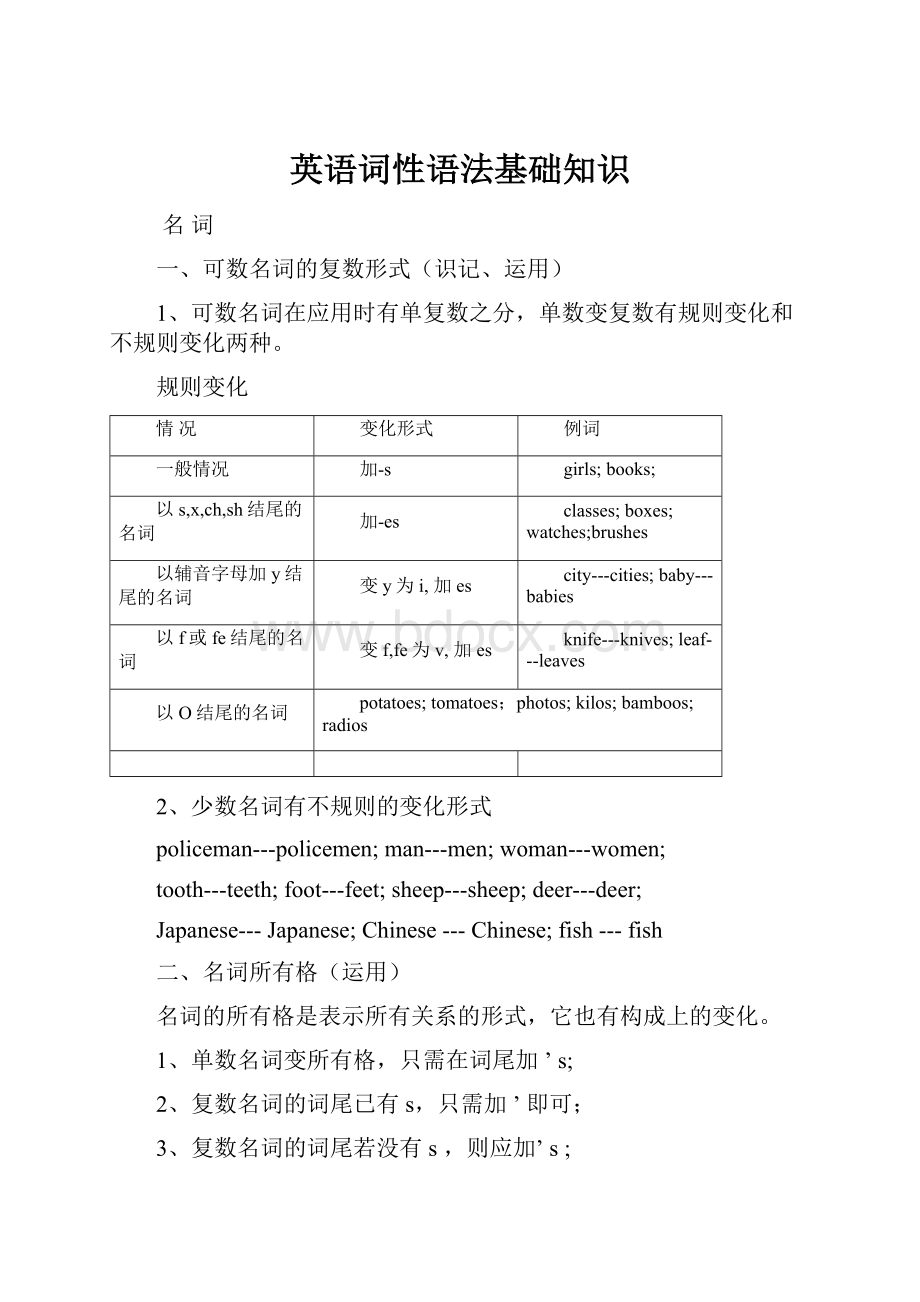英语词性语法基础知识Word格式文档下载.docx
《英语词性语法基础知识Word格式文档下载.docx》由会员分享,可在线阅读,更多相关《英语词性语法基础知识Word格式文档下载.docx(49页珍藏版)》请在冰豆网上搜索。

sheep---sheep;
deer---deer;
Japanese---Japanese;
Chinese---Chinese;
fish---fish
二、名词所有格(运用)
名词的所有格是表示所有关系的形式,它也有构成上的变化。
1、单数名词变所有格,只需在词尾加’s;
2、复数名词的词尾已有s,只需加’即可;
3、复数名词的词尾若没有s,则应加’s;
4、如果表示某人或物为两人所共有,则在第二个人后面加’s;
如:
DaMaoandXiaoMao’sroom
如果不是两人共有,则在每个人后面都加’s;
LiLei’sandTom’smother
5、名词所有格结构通常用于表示有生命的名词,或表示时间、距离、地点等,而表示无生命名词的所有关系则用“of”表示。
如:
thewindowsofhousethepictureofthefamily
of结构也能用于有生命名词的所有格。
afriendofmysister’sabookofhis
冠词
一、不定冠词的用法
a用于辅音音素起首的单词前,an用于元音音素起首的单词前。
1、当第一次提到某人或某物时,用a或an起介绍作用,如:
Whatisthis?
Itisabus.
Whoisshe?
Sheisadoctor.
2、表示泛指一类人或物
Asnakeisacold-bloodanimal.
Aplaneisamachinethatcanfly.
3、表示某一类人或事物的任何一个。
如:
Sheisateacher;
Thatisanapple.
Thereisanelephantinthezoo.
4、可用于某些词组,是该词组不可缺少的组成部分。
alongtimealittleafew
atatimehaveatrytakeachance
5、表示“每一个”的意思。
threetimesadayfouryuanadozen
6、可用于抽象名词之前,使抽象名词具体化。
Iamquiteataloss;
Thelittlechildisajoytohisparents.
7、用于物质名词之前,使物质名词普通化。
Hedrewoutatinofpineapple.
Theymadeafiretogetwarm.
注意:
1、不定冠词an用在以元音(不是字母,而是发音)起首的名词或其他以元音起首的词之前,不定冠词a用在以辅音起首的名词或其他以辅音起首的词之前。
2、u和h有时在单词中发元音,有时却读作辅音或不发音。
Ihavebeenwaitingforanhour.
Heisanhonestyoungfellow.
Ahammerisausefulfool.
3、英语中有些字母,如fhlmnsx。
由于它前头第一个音是元音,所以在单独使用或作缩略词的第一个字母时,应使用“an”,如:
Thereisan“n”intheword“no”.
AnMPmeansamemberofparliament.
二、定冠词的用法
定冠词the有this,that,these,those等意思,用于单数或复数名词前。
主要用来特指,使一个或几个事物区别于所有其他同名的事物。
1、指前文已经提到过的人或事物。
Iwroteanarticle.Thearticlewasaboutphysics.
2、指说话人都知道的人或事物。
Pleaseclosethedoorbeforeyouleave.
Let’sgototheclassroom.
3、名词有定语修饰时,须用定冠词the,表示特指意义。
Thebookonthedeskishis.
Theteacherwhotalkedwithyouishermother.
4、用于世界上独一无二的事物前。
thesunthemoontheearththeskytheworld
5、用在序数词前面表示顺序。
Iliveonthefourthfloor.
Mymotherisalwaysthefirstonetocomeandthelastonetoleave.
6、与其他词连用,构成固定词组。
ontheleftinthenorthinthefrontof
7、在表示乐器名称的名词之前用定冠词。
thepianotheviolin
8、用在形容词或副词的最高级前面。
Thiswasthemostinterestingvoyagewehadeverhad.
Heisthetallestofus.
9、用在形容词前面,表示复数意义的某一类人或事物。
therichthepoortheyoungtheliving
thenewtherightthetruethebeautiful
10、在表示江河、山脉、海湾、海峡、沙漠等专用名词之前加定冠词。
theChangjiangRivertheNile
theAlpstheHimalayas
11、用在年代、朝代、时代名词前。
theQinDynastytheMingDynasty
inthe50’sthespringperiod
12、和表示姓氏名词的复数形式连用,表示某姓氏一家人或夫妇二人。
theListheMartins
二、不用冠词的情况
1、除一些特殊情况外,专用名词以及抽象名词和物质名词前不加冠词。
Manismortal.
MissSmithcameinpoweratlast.
2、当名词前已有this,that,my,his,any,every,some,no,those,these等词修饰时或有所有格修饰时,不必加冠词。
Sheismysister.
Thisarticleyouhadwrittenisverywonderful.
3、在交通工具、学科名称等名词前不加冠词。
byplanebyboatChinesePhysics
4、在节日、假日、星期、月份、季节等名词前不加冠词。
NationalDayMayDay
AutumnJanuary
5、在一日三餐、体育类等名词前不加冠词。
Heprefersmilkandeggforbreakfast.
HepreferredtoplayfootballandI’dratherplaytennis.
6、在唯一的职务、头衔的名词前不加冠词。
Heiselectedmanagerofourcompany.
Peopleelectedhimpresidentofthatcountrylastyear.
7、在报纸标题、图像说明、文章题目、标志、广告前不加冠词。
Worker’sMind
NotesontheStudyofHongLouMeng
8、在一些固定词组中不加冠词。
athomebymistakelearnbyheart
atfirstatlastatonce
byseadayandnight
代词(
一、概述
代词是用来代替名词或名词短语的词。
代词的分类:
人称代词:
表示“我”、“我们”、“你”“你们”、“他、她、它”、“他们”的词叫人称代词;
物主代词:
表示所有关系的代词,分为形容词性物主代词和名词性物主代词;
反身代词:
表示动作反射到执行者本身或用来加强语气的代词;
指示代词:
表示能替代名词或替代形容词的词;
不定代词:
表示不指明替代任何特定名词的代词。
疑问代词:
表示替代人或物且含有疑问语气的代词。
二、人称代词
第一人称
第二人称
第三人称
单数
复数
主格
I
we
you
he,she,it
they
宾格
me
us
him,her,it
them
人称代词在句中可作主语、宾语、表语。
1、主格在句中作主语,宾格在句中作宾语。
Shegavethesebookstoyouandme;
Youmustlookafterthem;
2、当并列代词作主语时,I放在最后。
顺序为你,他,我
You,heandIaregoingtospendthewinterholidaysinBeijing.
三、物主代词
物主代词包括形容词性物主代词和名词性物主代词两种,有人称和数不清变化形式。
形容词性
my
our
your
his,her,its
their
名词性
mine
ours
yours
his,hers,its
theirs
形容词性物主代词只能作定语修饰名词,如:
mywatch;
yourbooks;
theirnames;
名词性物主代词在句中可单独作用,可作主语、宾语和表语,后面不跟名词,英语中说:
“我的一位朋友”,要用“afriendofmine”。
有些结构中常用the替代物主代词
Hehadacoldinthehead.(the意思是his)
Mymothertookmebythearm.(the意思是her)
四、反身代词
myself
yourself
himself;
herself;
itself
ourselves
yourselves
themselves
反身代词在句中可以加强语气,用作宾语和同位语。
Hehimselfhasfinishedit.(作同位语)
HehastaughthimselfRussianfor5years.(作宾语)
Ididitmysldf.(加强语气)
某些固定结构:
byoneself;
fooneself;
amongthemselves
Theymadethemachineallbythemselves.
Hecookedamealforhimself.
一、指示代词
指示代词有:
this;
that;
these;
those
this,these表示“这”、“这些”,是“近指”。
that,those表示“那”、“那些”,是“远指”。
在电话用语里面,用this代替自己,that代替对方。
who’sthat?
ThisisTomspeaking
二、不定代词
英语中有以下不定代词:
all,each,every,both,either,neither,one,none,little(alittle),few(afew),many,much,other,another,some,any,no还有由some,any,noevery构成的代词。
1)both,all
both是指“两者都”,而all则是指“三者或三者以上都”,如:
Bothofusareright.
Allofyouaregoodatplayingbasketball.
但all还可以组成固定短语allday,allthis,allthetime等
2)either,neither
either是指“两者之中任何一个……“属于部分否定,而neither则是“两者之中一个也不……“属全部否定
Eitherofthebookswilldo.
Neitheroftheanswersisright.
而either还可出现在否定句子里,可与neither进行句型转换。
Tomhasn’tbeentoAmerica,Jimhasn’t,either
=NeitherTomnorJimhasbeentoAmerica.
而neither(nor)也可用于表示“也不……”,构成“neither(nor)+助动词+主语”的句式。
Kateisn’taworker,neitherisMeimei.
3)little,alittle,few,afew
little,alittle修饰不可数名词;
few,afew修饰可数名词;
little,few表示否定,“几乎没有”
alittle,afew表示肯定,相当于some,any.
Thereisalittlemilkintheglass.
Therearefewstudentsintheclassroom,they’reinthereading-room.
4)every,each
every,each都是强调每一个,every作定语修饰名词。
Thebuscomeseveryfiveminutes.
Eachofthemmaycomeatadifferenttime.
5)some,any
6)由some,any,no,every组成的不定代词
something,someone,somebody,somewhere,anything,anyone,anybody,anywhere,nothing,none,nobody,nowhere,everything,everyone,everybody,everywhere.
时间和年月日表示法
1、时间均用基数词表示:
1)顺读法,先说“点钟”,再说“分钟”,如:
2:
15twofifteen6:
20sixtwenty
2)逆读法
30分钟以内:
“分钟数+past+钟点数”,如:
3:
20---twentypastthree2:
10---tenpasttwo
半小时用half,15分钟用aquarter:
15---aquarterpasttwo3:
30---halfpastthree
30分钟以外要用:
“分钟数+to+下一个钟点”,如:
4:
35---twenty-fivetofive2:
55---fivetothree
2)年月日表示法
年份读法;
月日读法;
年月日一起读法。
四、分数的表示法
当分数中表示分子的数只含个位数时一般采用“分子(用基数词)+分母(用序数词)”表示。
(分子大于1时,分母序数词用复数)如:
one-third;
two-thirds;
threetwenty-seconds
介词
一、介词的定义及句法功能
介词是一种虚词,在句中不单独作任何句子成分,只表示其后的名词或相当于名词的词语与其他句子成分的关系。
介词后的名词,或相当于名词的其他词组、短语或从句,称为介词宾语。
介词和介词宾语一起构成介词短语。
介词短语在句中主要用作定语、状语、表语和宾语补足语。
Theboyoverthereismybrother.(作定语)
Afriendinneedisafriendindeed.(作定语)
IshallmeetyouattheentranceofQianmenHotel.(作地点状语)
Totheirsurprise,theysawnotlocusts,butseagulls.(作原因状语)
I’llbeintheofficeeveryafternoon.(作表语)
Heisn’tathome(作表语)
Thefarmermadethekingoutofthewater.(作宾语补足语)
Ifoundeverythingingoodorder(作宾语补足语)
三、介词与其他词类的固定搭配。
介词和动词、形容词、名词等常构成固定搭配。
也就是说,在这些词的后面,常常要求用一定的介词。
1、形容词与介词的固定搭配
有些形容词后面要求用固定的介词,这类介词常见的有:
about,at,for,from,in,of,to,with
(1)形容词+about
carefulabouthopefulaboutsureabout
Heiscarelessabouthisclothes
(2)形容词+at
goodatsurprisedatangryat
(3)形容词+for
famousforreadyforsorryfor
I’mterriblesorryfortellinghimthetruth.
(4)形容词+from
differentfromsafefrom
Hewasabsentfromclassthismorning
Mysisterisdifferentfrommeinmanyways.
(5)形容词+in
interestedinsuccessfulin
Heisinterestedinmakingmodelships.
2、名词与介词的固定搭配
(1)名词+for
Hemadeupanexcuseforbeinglate.
Didyoufindthecauseforyourfailure?
(2)名词+in
Hehassomedifficultyintranslatingthebook
ShehasmadegreatprogressinEnglish.
(3)名词+of
Shefoundanotherwayofsolvingtheproblem
Heformsabadhabitofgettinguplate
(4)名词+on
Therehavebeenseveralattacksonforeignersrecently.
Havepityonme!
(5)名词+with
Iwantedtohaveatalkwithyou
Heisalwaysgettingintotroublewiththepolice
动词
一、动词的分类及作用
按照动词的词义和在句中的作用,英语动词可分为行为动词(又叫实义动词)、连系动词、助动词和情态动词。
1、行为动词
表示动作或状态,能独立作谓语。
Shetookpicturesoftrees
Heistypingletters.
行为动词又分为及物动词和不及物动词。
(1)及物动词
及物动词后面必须跟宾语,意思才完整。
Ienjoyedthefilmverymuch
Igavethechildanotherpieceofcake.
常见的能带两个宾语的动词有:
bring,build,buy,cook,cut,draw,find,get,hand,leave,lend,make,offer,pass,pay,read,return,sell,show,teach,tell,write,etc.
(2)不及物动词
本身词义完整,后面不要求跟宾语。
Horsesrunfast.
Theyworkinafactory.
Shecurledupinbedandbeganherbook.
2、连系动词
(1)本身有词义,不能在句子中单独作谓语,必须和表语一起构成谓语。
常见的连系动词有:
be,look,get,feel,sound,turn,smell,taste,become.
Myfatherisanengineer.
Mybrotherhasbecomeadoctor.
Itseemsthathewasamillionaire.
Idon’tfeelverywelltoday.
(2)表示感觉知觉的动词可以是连系动词,如feel,touch,sound,smell.
Icansmellthesea.
Thecustomsofficerlookedcarefullyattheirsuitcases.
Ifeelapaininthearm.
Shelookedworriedaboutit.
3、动词与介词的固定搭配
动词与介词的搭配主要指下列两种形式:
(1)动词+宾语+介词
Thesongalwaysremindsmeofmyschooldays.
Parentsusuallyexpectalotoftheirchildren.
Ioftentakeherforhersister.
He